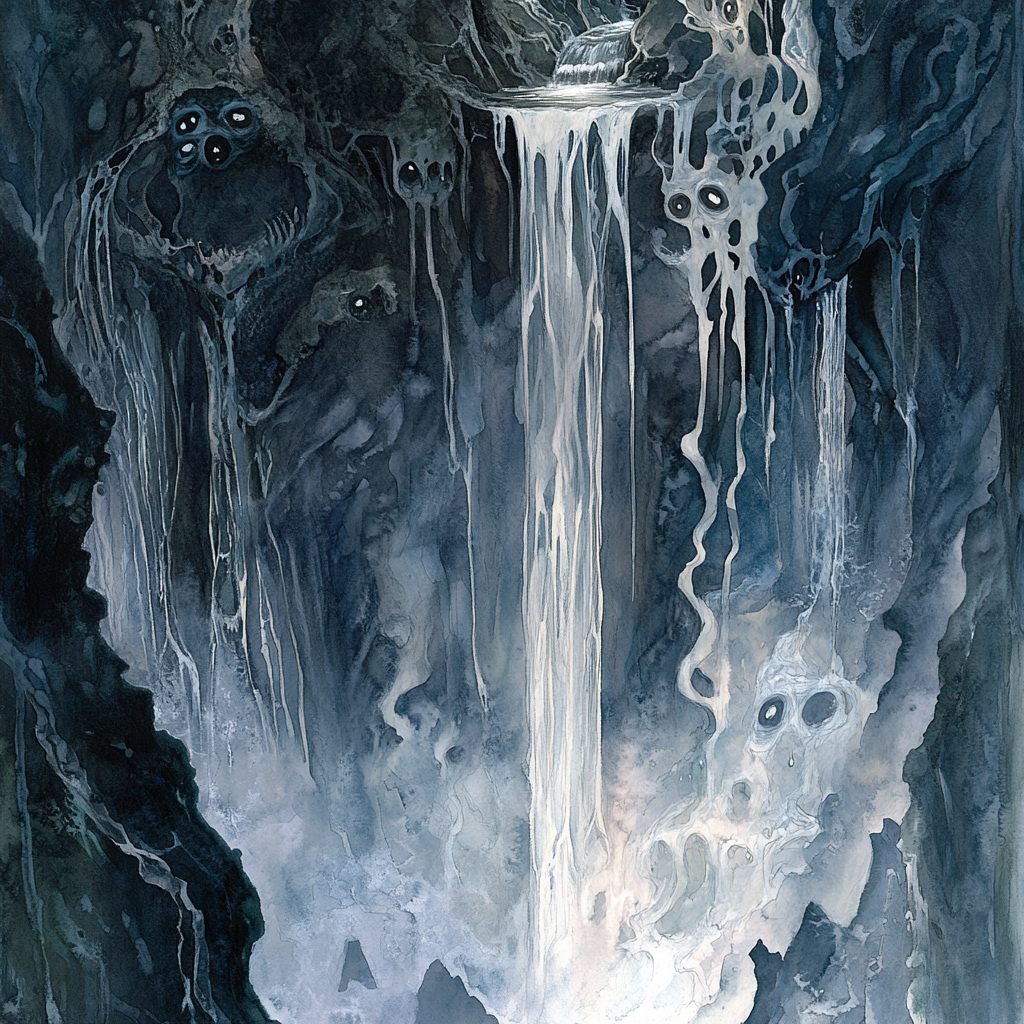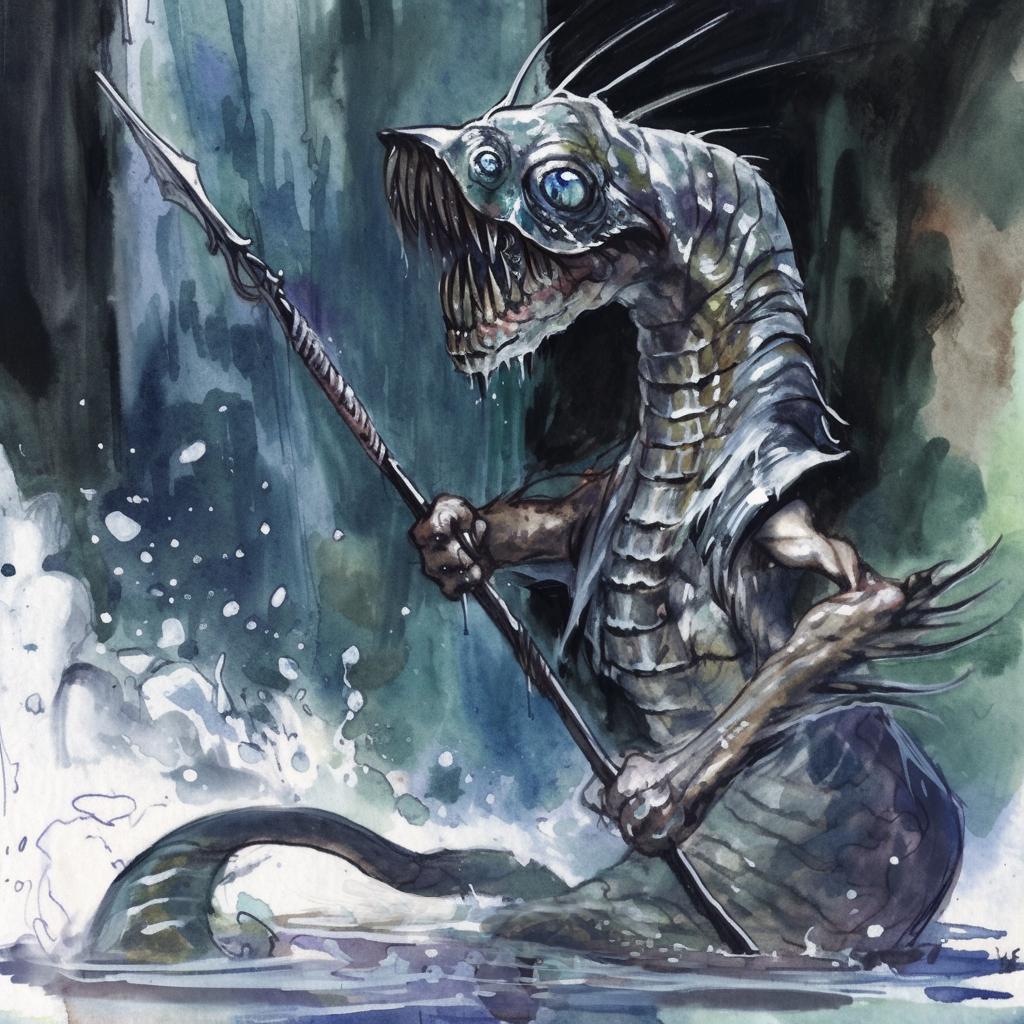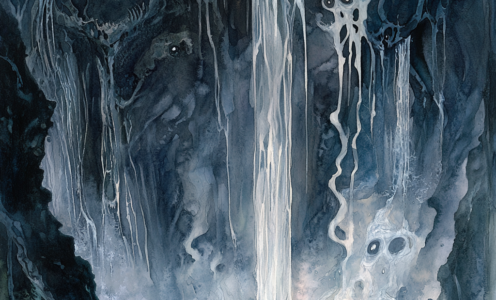Singing Falls
Location: Abyss / Layer 4—Grand Abyss

The Singing Falls are a disturbing landmark of the Grand Abyss; an endless waterfall that cascades into the darkness below. But the liquid that flows here is not water—it is an eerie, translucent liquid that glows with a ghostly light. Unlike most rivers in the Abyss, it is unnervingly clean, its surface reflecting distorted images of those who gaze upon it. The Falls do not splash or roar as they tumble; instead, they scream—a harrowing cacophony of mournful wails and cries that echo through the chasm. To most mortals, the sound is unbearable [inducing terror as if under the effects of a fear spell cast at 12th level]. To the tanar’ri, however, it is a melody of exquisite beauty, and it draws them like moths to a flame. The air around the falls is cold and damp, and carries an unsettling sense of despair that clings to the soul.
Chant goes that the Singing Falls are a conduit for the anguish of the damned, and a source of dark vitality for many layers of the Abyss. While the main body of the falls seems to cascade down endlessly, each time the falls pass a gate, churning mist emanates from the flow and gently swirls around the gate. As the liquid anguish washes deeper into the Abyss, its dark energy nourishes the deeper layers.
The true source of the falls remains unknown; some say it originates from the badlands of Pazunia as a cruel mockery of celestial purity, while others believe it is distilled directly by the suffering of those trapped in the Abyss. The falls serve as both a punishment and spectacle—and a reminder of the plane’s endless thirst for torment. Some tanar’ri claim that lingering near the falls allows them to absorb fragments of anguish, revitalising them. Indeed, fiends bathed in the liquid of the falls do seem stronger and more focussed, but this effect diminishes quickly as they dry off.
The area around the falls is treacherous; rocks slick with screams and unstable ledges make any misstep potentially fatal. The psychic effects of the wailing can disorient even sturdy planewalkers, leaving them vulnerable to ambush by the sinister creatures that dwell in the Falls.
Denizens of the Singing Falls

Wailing Echoes are ghostly manifestations of tormented petitioner souls that drift near the falls. These spectral beings lash out at intruders with psychic screams and try to possess those who linger too long.
Abyssal Sirens are demonic entities resembling twisted merfolk with barbed tails and translucent skin. They bask in the falls’ screams, using their own hypnotic voices to lure mortals closer before dragging them into the abyss.
The Keeper of Lament is a solitary figure known as Sorraskh (planar wastrilith tanar’ri [she/her] / CE), an ancient wastrilith who guards the falls. Sorraskh claims to “conduct” the screams like an orchestra, shaping their tones for her own dark amusement. She views anguish as art and believes suffering is a form of perfection. Sorraskh is both a philosopher and a predator, offering cryptic insights to visitors before attempting to ensnare them in her soundscape of despair.
The Myth of the Weeping Architect
Long ago, before there were tieflings, there existed a being known only as the Architect of Anguish. Neither tanar’ri nor mortal, the Architect was said to be a primordial entity, perhaps one of the obyrith—a sculptor of suffering, who gave shape to the endless hunger of the Abyss. It is whispered that the Singing Falls are the Architect’s final creation.
According to the myth, the Architect sought to create a masterpiece that would embody the essence of torment. To do so, they carved a great wound into the cliffside of the Grand Abyss, a scar so deep that it bled shadows. Into this chasm, they poured the distilled anguish of countless souls—beings who had been devoured by the Abyss but whose suffering had not yet been extinguished. The liquid that now forms the Singing Falls is said to be their collective sorrow, liquefied and eternal, still flowing to this day. The screams that echo from its descent are their final cries, amplified by the chasm’s walls into an unending chorus of despair.
The myth grows darker still. It is said that when the Architect completed their work and gazed upon their creation, they were overcome by its beauty—and its horror. For in shaping such perfect agony, they had inadvertently bound themselves to it. The Abyss, pleased with their work but unwilling to let such talent go to waste, cursed the Architect to become one with their masterpiece. Their essence was dissolved into the falls, their screams joining those of the souls they had condemned. They say that if you can bear to listen for long enough, you might hear a single voice rising above the cacophony—a voice filled with both pride and unbearable regret.
Despite—or perhaps because of—its dark history, some fiends make pilgrimages to the Singing Falls. Cultists devoted to pain and despair see it as a sacred site, believing that bathing in the liquid will grant them insight into true suffering, or purify them through anguish. None who attempt this return unchanged; most are driven barmy or consumed entirely by the falls’ relentless pull. Whether it is truly a monument to suffering or simply another cruel trick of the Abyss is a question only those brave—or foolish—enough to visit may attempt to answer.
Source: Jon Winter-Holt and Layers of the Abyss — material adapted from the excellent netbook authored by Eli Atkinson, Will Church, Serge W. Desir Jr., Marley Sage Gable, John Harris, Sam Peer, Adam Silva-Miramon, Sean Surface


